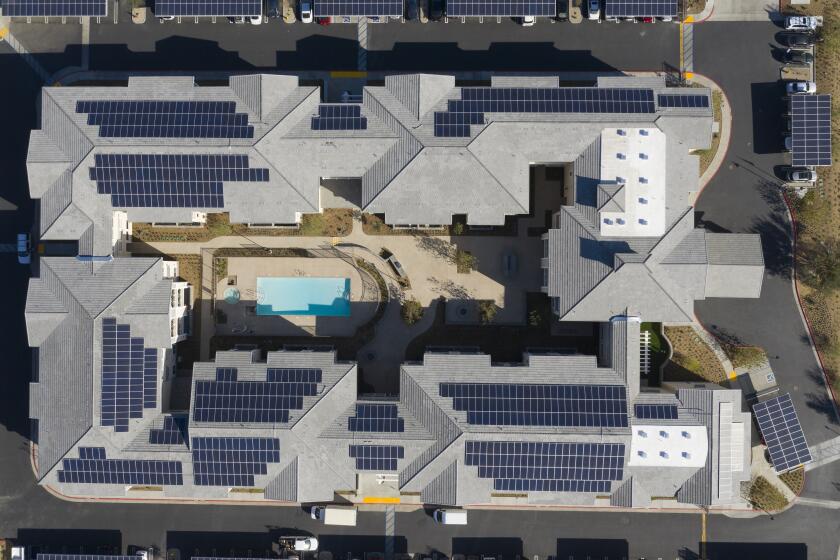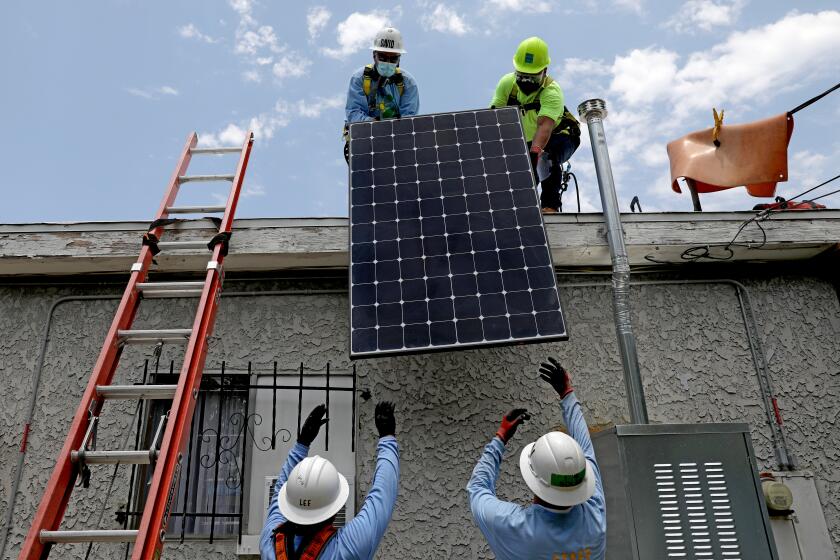Column: How California’s rooftop solar program became a victim of its own spectacular success

- Share via
There’s one aspect of California’s program to spur the installation of rooftop solar panels that everyone can agree on: It has been spectacularly successful.
Launched in 1995 and pushed forward a decade later, when then-Gov. Arnold Schwarzenegger set a target of 1 million solar installations, the program has handily exceeded that goal.
Today there are more than 1.2 million rooftop systems in place, most of them atop residential buildings. That has made California — where an estimated 15% of electric generation comes from rooftop systems — the national leader in the technology.
California’s distributed solar policy hurts the poor. It really is that simple.
— UC Berkeley economist Severin Borenstein
But now the program is showing its age. It has been so successful, in fact, that some of its unintended consequences have become too significant to ignore.
Chief among them is that the incentives awarded to homeowners installing rooftop solar systems have raised costs on consumers who haven’t joined the trend — or can’t. These include renters and lower-income families.
Get the latest from Michael Hiltzik
Commentary on economics and more from a Pulitzer Prize winner.
You may occasionally receive promotional content from the Los Angeles Times.
“California’s distributed solar policy hurts the poor,” UC Berkeley energy economist Severin Borenstein observed last June. “It really is that simple.”
Enter the California Public Utilities Commission, which on Dec. 13 proposed a sheaf of changes to the state’s incentive program, aimed at addressing its embedded inequities.
Among other features, the PUC’s plan would impose a monthly charge of $8 per kilowatt on rooftop solar installations. That would come to about $56 a month for the average system in Southern California Edison’s zone in Southern California, and about $48 for the average system in Pacific Gas & Electric’s Northern California region.
The PUC would also slash the so-called net metering incentives enjoyed by rooftop solar customers. Under net metering, the utilities pay those customers for the excess electricity their home systems generate and transmit to the utilities’ grid.
That’s the key to the reductions those customers see on their electric bills. But it has long been clear that the net metering paybacks are overly generous, even lavish. The PUC proposes to cut those subsidies by more than 80%.
The commission also proposed a $600-million fund to subsidize rooftop solar installations by low-income residents. And it acknowledged that in the future, California’s solar program should accommodate both rooftop solar panels and high-capacity home batteries. But it stated that the current cost of home electrical storage is too high to justify it on a cost-benefit basis.
Want to go solar, or already have rooftop panels? Here’s how proposed changes would affect you.
The PUC’s proposal predictably triggered an uproar.
One solar industry lobbyist called the proposal a “clean energy and jobs disaster.” An advocate of renewable energy accused the big utilities of plotting to cripple rooftop solar so they can protect their profits.
In an op-ed earlier this month, Schwarzenegger called the PUC’s monthly fee proposal a “solar tax” and implied that the proposal is a sop to the big utilities. (Schwarzenegger, curiously, published his screed in the New York Times, so it’s proper to wonder what audience he was aiming for.)
Column: Nuclear energy backers say it’s vital for the fight against global warming. Don’t be so sure
Nuclear power proponents say their technology is ‘green.’ But the history of nuclear power is one of broken promises of safety and profitability.
Schwarzenegger’s assertions contradicted his position in 2019, when he celebrated the state’s one-millionth rooftop installation by telling my colleague Sammy Roth that the price of solar had come down so much that “now we don’t need any more subsidies.”
The solar industry and some of its customers have become, in effect, addicted to those subsidies, treating them as their right. They assert that reducing the incentives could stifle rooftop solar growth, though the degree to which that may happen is subject to debate.
The energy consulting firm Wood Mackenzie on Wednesday projected that the proposal could cut the market for residential solar in half by 2024.
The firm said the proposal would stretch the payback period — the time it takes for the savings from rooftop solar to cover the systems’ upfront costs — to as long as 15 years from the current range of five to six years. That’s enough to discourage many homeowners from making the investment.
The PUC, however, says its proposal is structured so that new solar installations, when paired with batteries, would be paid back in less than 10 years.
But Wood Mackenzie also projected that the market would start to recover in 2025, assisted by continuing price declines in solar and storage equipment.
There can hardly be any question that the benefits of the rooftop solar revolution have been inequitably shared. That’s because of two main flaws in the program.
Clean energy activists and utility giants are duking it out over the future of rooftop solar.
One is that solar customers avoid paying for the vast majority of costs of operating and maintaining the state’s overall electrical grid. That’s because their electric bills are based on only the amount of power they consume from the utilities — much less than do non-solar households.
Not enough has been written about what’s actually inside President Biden’s budget reconciliation bill, and how it would help the U.S. reach its goals for reducing global warming.
The PUC estimated that rooftop solar customers cover only 9% to 18% of costs such as wildfire mitigation, compensation for wildfire victims and routine maintenance, depending on their utility provider. The balance is shouldered by non-rooftop customers. As that segment shrinks, their burden rises. The PUC’s Public Advocates Office estimates the shifted cost at $3.37 billion in 2021, though other stakeholders contend that figure is lower.
The other flaw is that the payments received by solar customers for their excess electricity are much higher than the electricity is really worth.
“Solar customers in California are now paid up to six times what electricity generated by solar panels is worth to the grid and to reduce carbon,” a study by the Natural Resources Defense Council — an advocate of expanding solar generation — reported last year. The reason is that net metering payments are based on the price of the electricity charged by utilities, not the marginal value of the electricity that solar customers return to the grid.
Another factor contributing to inequities in the program is the natural phenomenon that the advent of new technologies initially favors the affluent. They’re the people with the disposable capital to invest in untested innovations as well as the mind-set to try something new; they’re more likely to respond to financial incentives, too.
The risk is that low- and middle-income people eventually get left behind. This happened most recently with the rollout of electric cars: A 2016 study from UC Berkeley found that 83% of the recipients of state rebates for electric and hybrid vehicles reported incomes over $100,000.
The state that year refocused the rebate program on middle- and lower-income buyers by eliminating incentives for luxury EVs and placing income limits on all recipients.
Rooftop solar expansion shows the same economic mismatch, because it lends itself to installation on owner-occupied single-family homes.
As a result, according to a study by Lawrence Berkeley National Laboratory cited by the PUC, only about 13% of net metering customers come from the lowest 40% of households by income, while 43% come from the top 20% of income earners.
The Berkeley Lab also pinpointed a racial aspect of the economic discrepancy. “Solar-adopters tend to live in neighborhoods with relatively high non-Hispanic White and Asian populations, and with relatively low Hispanic and Black populations,” the lab found.
Exxon Mobil shareholders may force change on the giant oil company, starting this week.
A study of the net metering program commissioned by the PUC found that fewer than 12% of all the net metering systems in the state were installed in disadvantaged communities.
Every major social or technological transition creates new winners and losers. The challenge is to make sure that the winners aren’t winning by extracting their gains in a way that creates a social pathology that’s bad for everyone.
As Borenstein and his colleagues observe, the shift of electrical costs to a shrinking base of lower- and middle-income households will force the latter’s power costs to rise, which can only “discourage some households from considering electrification of space heating, water heating, clothes drying, vehicle transportation and other services that can switch between energy sources.” That wouldn’t be good for California’s transition away from fossil fuels.
What does all this mean for the future of California’s solar rollout?
One imperative is to acknowledge the program’s evident flaws. Even the Sierra Club and the Natural Resources Defense Council, strong supporters of solar power, agree that the program’s inequities need to be addressed. (The Sierra Club, however, contends that elements of the PUC’s proposal are too extreme and possibly illegal, and their planned implementation so abrupt that they would “devastate” the California solar industry.)
So, too, do leading consumer advocates such as the Utility Reform Network and the PUC’s Public Advocates Office, which both submitted their own proposals for reform of the net metering program.
It’s important to ratchet down the turbocharged rhetoric being tossed around. It sometimes seems as if the participants in the debate are more concerned with impugning one another’s motives than addressing the genuine issues.
It’s also important to clear away some of the obfuscation clouding the debate. Solar industry advocates assert, for instance, that low-income residents already benefit from rooftop solar because it makes the overall electric grid less dependent on fossil fuels that contribute to global warming. They argue that discouraging rooftop solar will mean more fossil-burning electric generation, and that solar installations are already ramping up in disadvantaged communities.
That’s all misleading, however. Many of the calculations showing economic inequities in the solar rollout already account for how the benefits of rooftop solar flow to nonparticipating customers.
The alternative to rooftop solar isn’t more fossil fuel-burning plants but large-scale solar and wind farms, which present ecological challenges but also can be economically more efficient than small-scale rooftop generation.
It’s true that rooftop solar has been penetrating low-income neighborhoods, but only slowly.
“You’re kidding yourself if you believe working-class communities currently have any kind of substantial rooftop solar,” former Assemblywoman Lorena Gonzalez Fletcher (D-San Diego) remarked recently on Twitter. “They’re simply paying for others’ subsidies.” Fletcher is due to take over as head of the California Labor Federation this summer.
Inevitably, the PUC’s current proposal almost certainly won’t be the last word on the future of net metering and rooftop solar in California. Almost certainly, the details proposed by the PUC, including its monthly charge and the price that residents get for their excess power, will be the subjects of compromise.
An alternative proposal may emerge from within the commission, and Gov. Gavin Newsom already has indicated that further discussion is warranted. Portraying the PUC plan as an all-or-nothing choice won’t get the state any closer to a resolution.
All that’s clear is that the rooftop solar program needs to evolve. Let’s hope that Californians are clear-sighted enough to conduct the debate on the merits.
More to Read
Get the latest from Michael Hiltzik
Commentary on economics and more from a Pulitzer Prize winner.
You may occasionally receive promotional content from the Los Angeles Times.
















